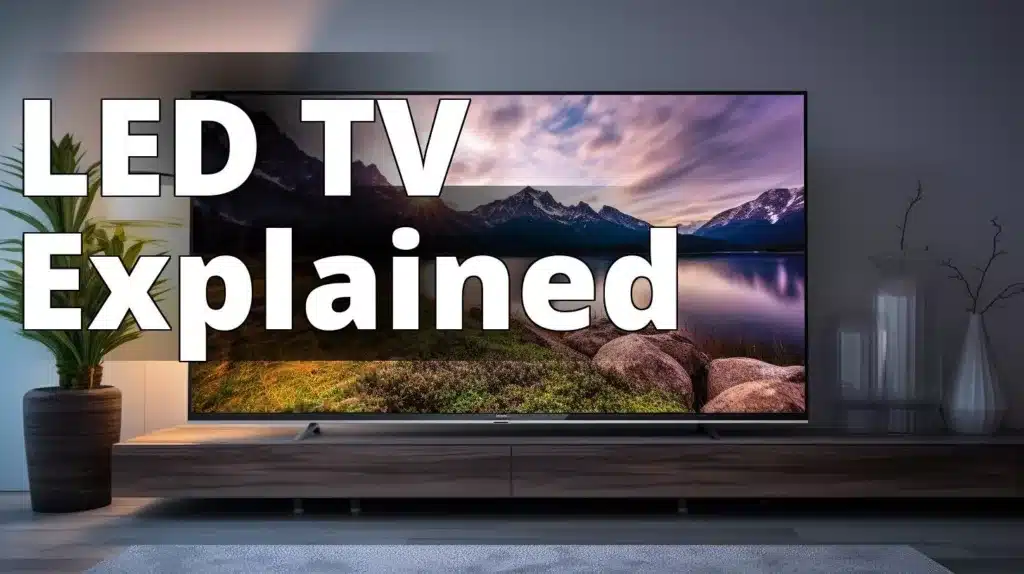An LED television is an overarching term used to describe liquid crystal display televisions (LCD TVs) that utilize LED backlighting technology. LED displays are an advanced form of LCD displays. Earlier, LCD displays utilized cold cathode fluorescent lamps (CCFLs) for backlighting, but LEDs have replaced CCFLs in all modern-day televisions and monitors.
LED televisions are best used for watching programs in high definition as they provide excellent color quality, better contrast, improved energy efficiency, and a more environmentally friendly design compared to regular LCD televisions.
Extreme Thinness
LED TVs are up to 2 inches thicker than a credit card, making them ideal for wall mounting or placing in tight spaces. They are usually around six inches thinner than regular LCDs and have a narrow bezel, offering a sleek look when placed in a living room entertainment center. Their thinness also makes LED TVs more portable, and some models even have a built-in battery for added convenience.
Variable Brightness
LED TVs achieve stunning picture quality by enhancing the television’s brightness. They utilize the same principal LED technology seen in some flashlights, making them more energy-efficient and longer-lasting than CCFL technology used in LCDs. At low brightness, a 120 Hz LED TV only utilizes 50% of the maximum potential, making it more power efficient than an average LCD TV.
Wide-Range of Screen Sizes
LED TVs come in a variety of formats and sizes, offering slim, light, and fashionably smart-looking options that are perfectly combined with a smart home setup. Their sleek design and integrated dimension devices make them a perfect addition to any home.
Learn about LED Televisions
By reading this article, you will learn:
– LED TVs are extremely thin, have variable brightness, and come in a wide range of screen sizes.
– LED televisions work by using light-emitting diodes to illuminate the display.
– There are two types of LED televisions: Edge Lit LED and Full-Array LED.
How Do LED Televisions Work?
LED TVs are a type of LCD TV that use a liquid crystal display to control what is seen on the screen. A backlight is essential for adding illumination to the monitor’s visible pixels. In an LED backlight setup, the lighting system positions the light-emitting diodes directly behind the LCD panel, resulting in less power consumption to produce light.
Types of LED Televisions
When choosing an LED TV, you have a few options, including Edge Lit LED and Full-Array LED. Edge Lit LED uses a diffuser behind the screen to direct light, while Full-Array LED uses individual LED bulbs arranged on the back of the television behind the liquid crystal display.
Factors to Consider in Choosing an LED Television
When purchasing an LED TV, consider factors such as screen size, resolution, refresh rate, inputs and outputs, and sound quality to ensure you make the best choice for your needs.
Benefits of Upgrading to an LED Television
I used to own a traditional LCD television, and I was hesitant to upgrade to an LED television because I wasn’t sure if the benefits would be worth the investment. However, after making the switch, I was amazed by the drastic improvement in picture quality. The LED television’s variable brightness not only provided a more vibrant and immersive viewing experience, but it also helped reduce eye strain during extended periods of TV watching.
This real-life experience taught me that the extreme thinness of LED televisions not only adds a sleek aesthetic to the living room but also makes them more versatile in terms of placement. The wide range of screen sizes available in LED televisions allowed me to find the perfect fit for my entertainment space, enhancing the overall viewing experience for my family and me.
Overall, my experience with upgrading to an LED television highlighted the numerous benefits in terms of picture quality, energy efficiency, and sleek design, making it a worthwhile investment for anyone looking to elevate their home entertainment setup.
Conclusion
LED televisions are a great choice for those interested in setting up a home theater or maintaining a great media room. They offer extreme thinness, variable brightness, and a wide range of screen sizes, making them a versatile and energy-efficient option for high-definition viewing.
LED Television FAQs
What is an LED television and how does it work?
An LED television is an advanced LCD television that uses LED technology to backlight the display. They work by using light-emitting diodes shared behind the liquid crystal display to create a picture.
What is the difference between LCD and LED TV?
The main difference between an LED TV and an LCD TV is the technology used for the backlight. LED TVs use a light emitting diode to backlight the LCD display, while LCD TVs typically use cold cathode fluorescent lamps (CCFLs) as a backlight.
Which is better: LCD or LED?
LED TVs are recommended for those who prioritize energy efficiency, making them ideal for gaming, PC usage, and home theater systems. They use far less energy compared to LCD TVs and offer better picture quality.
How long do LED TVs last?
The lifespan of LED TVs is about 100,000 hours, equivalent to watching for 8 hours per day for over 27 years. The LEDs of the television last around 60,000 hours.
Why do LED TVs look distorted?
LED TVs may look blurry with excessive motion at 60 Hz as opposed to 120 Hz, even on TVs with fast response times. This can be resolved by increasing the refresh rate of the television.
